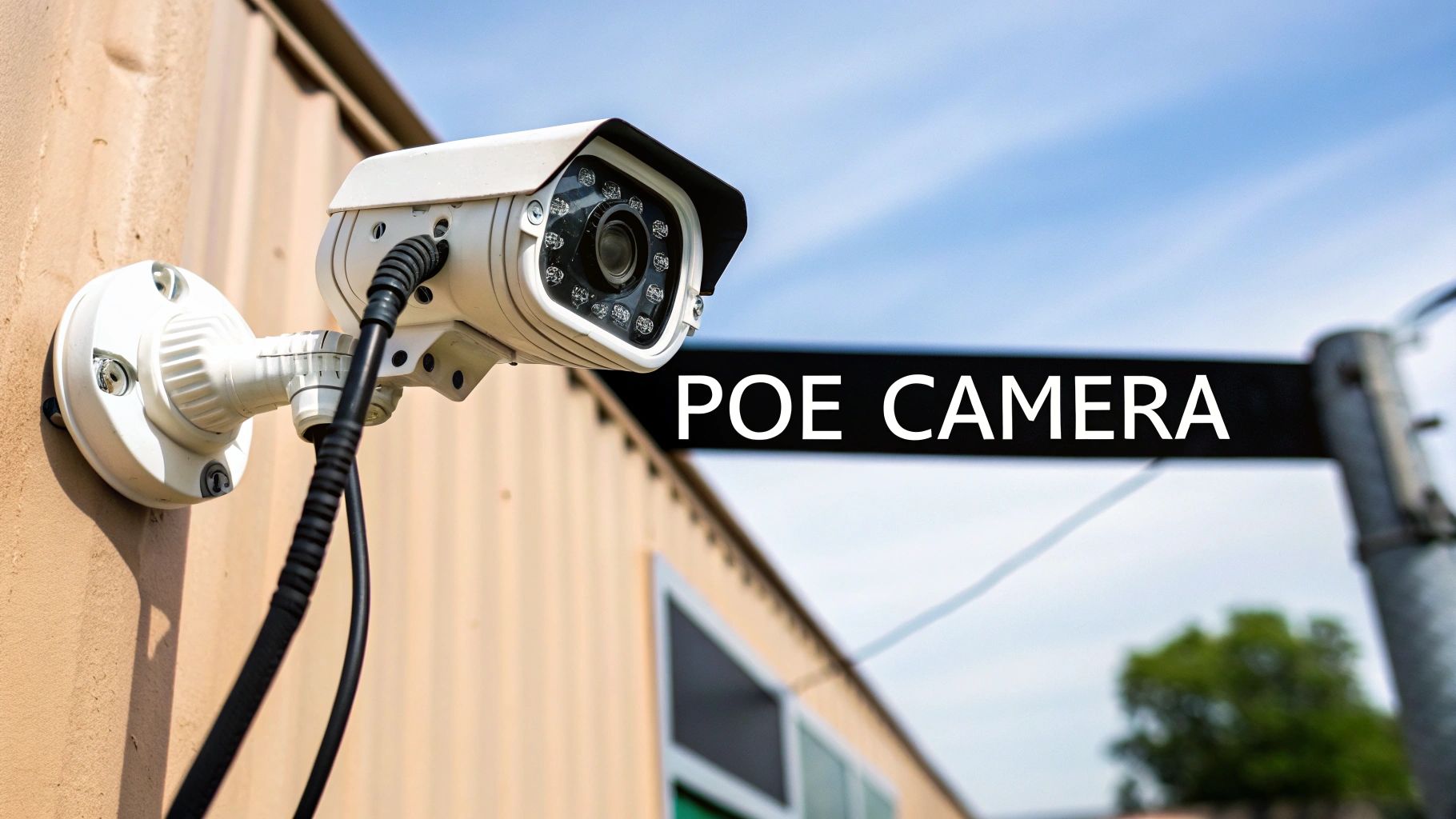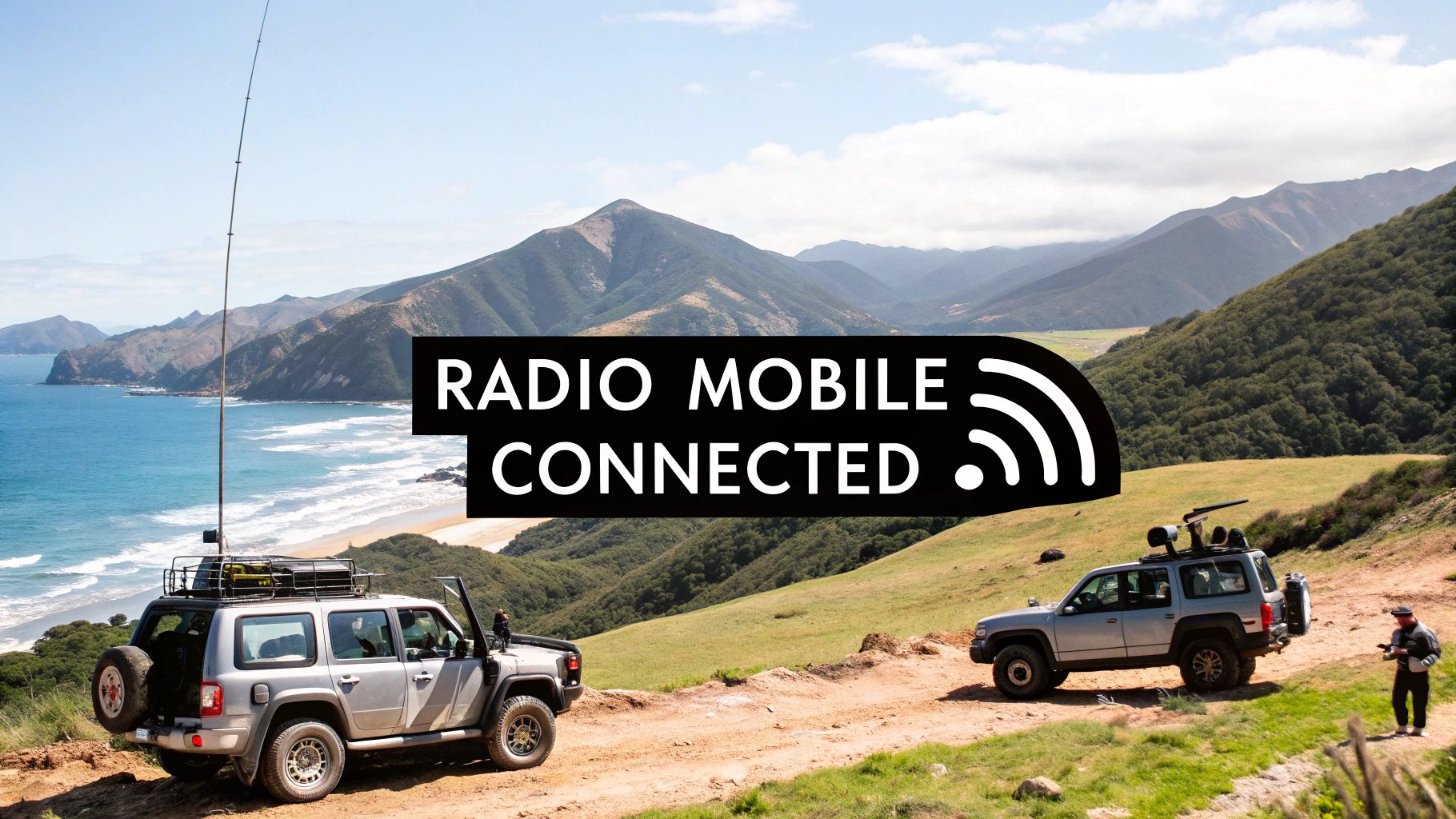NZ Satellite Communications: A Guide to Team Safety and Connectivity
Picture your team working deep in the rugged backcountry of the South Island, miles from the nearest cell tower. Or maybe they're on a vessel far off the coast. How do they stay connected? More importantly, how do you ensure they're safe? This is exactly where satellite technology comes in, shifting from a niche luxury to an essential tool for New Zealand businesses looking to drive productivity and guarantee worker safety. Today's satellite communications are not just about emergency contact; they are about exploiting efficiencies and productivity gains associated with reliable, always-on connectivity.
The New Frontier of NZ Business Connectivity
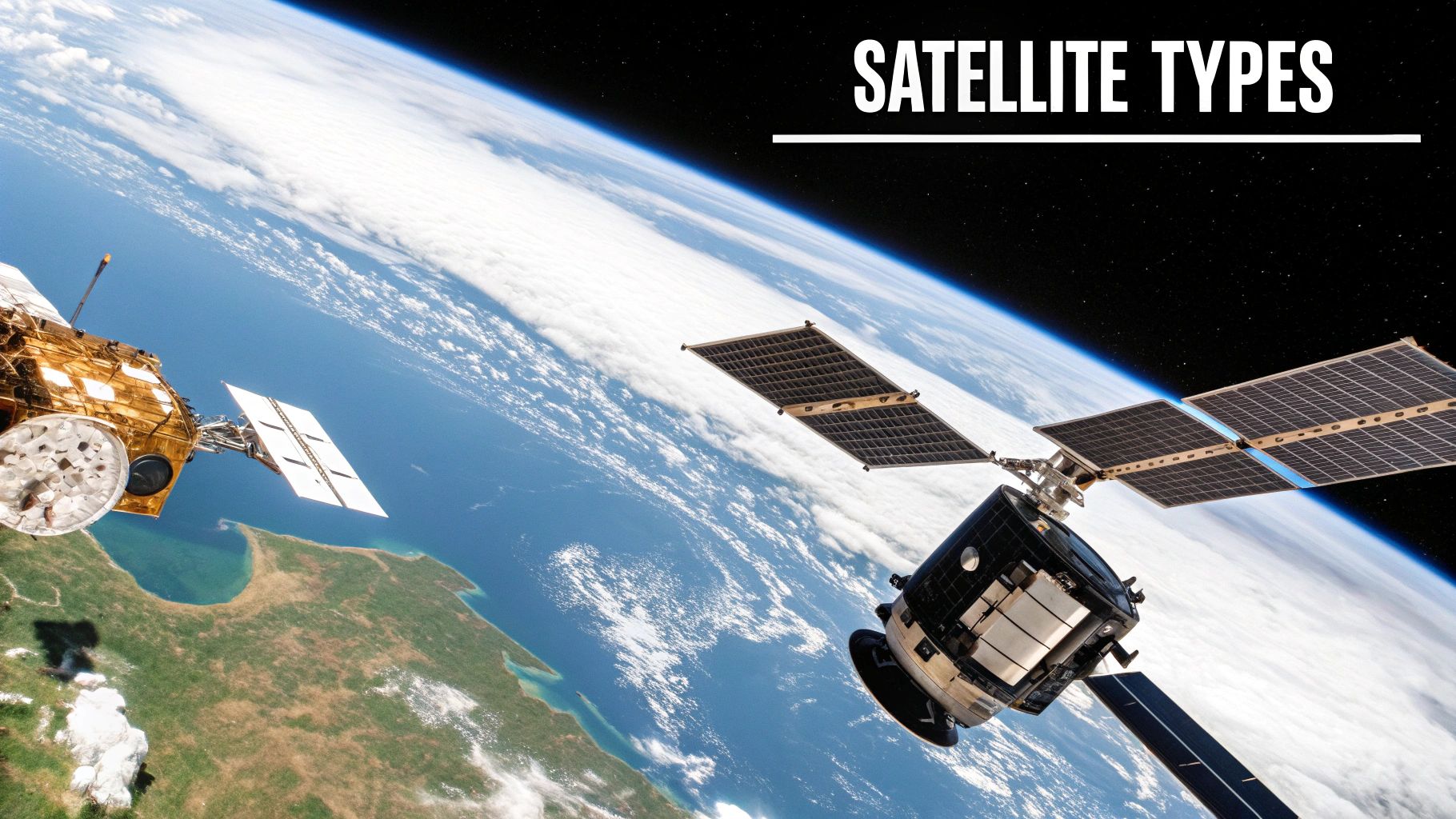
In New Zealand's unique and often demanding geography, reliable communication isn't just a nice-to-have—it's absolutely critical for safety and operational efficiency. For industries that operate in the remote corners of our country, from forestry and farming to marine and construction, the dead zones of the cellular network are a daily reality. This is where modern satellite systems provide a powerful, game-changing solution.
Think of a satellite as a permanent communications tower floating in the sky. It orbits the Earth, picking up signals from a device on the ground and bouncing them back to a network hub, which then connects to the global internet or phone network. This concept creates a communication lifeline that completely sidesteps the need for ground-based infrastructure like cell towers or fibre cables.
Why Satellite Matters for Kiwi Industries
The payoff for New Zealand businesses is massive. Connectivity is no longer just about convenience; it drives efficiency, underpins worker safety, and unlocks productivity that was simply out of reach before. In a country where much of the landmass has patchy or non-existent mobile coverage, satellite is often the only realistic way to get true nationwide reach.
For some of our key industries, this technology offers very real advantages:
- Forestry: Crews in remote blocks can send real-time data, get updated instructions, and, most crucially, have a reliable channel to call for help in an emergency.
- Agriculture: High-country farmers can use satellite internet for precision agriculture, monitor remote equipment, and manage their business operations without driving back to town.
- Marine Operations: Commercial fishing boats and recreational boaties can get the latest weather updates, stay in touch with the shore, and use emergency beacons like EPIRBs and PLBs far beyond the reach of coastal cell service.
"For teams operating beyond the reach of traditional networks, a satellite connection isn't just about sending an email. It’s the link that confirms a worker is safe, a project is on track, and that help is available at the press of a button."
Driving Business and Worker Safety
Ultimately, the latest developments in satellite technology are making it more affordable and indispensable for Kiwi businesses. It bridges the communication gap created by our rugged terrain, letting companies find new efficiencies through better logistics coordination, real-time asset tracking, and much stronger health and safety protocols. These communications are designed to keep your team safe and in touch, driving business forward.
As costs continue to drop and performance improves, satellite solutions are quickly becoming a standard part of the toolkit for any forward-thinking New Zealand business. If your work takes you beyond the city limits, it’s time to look to the sky. The team at Mobile Systems Limited can assist with satellite solutions in New Zealand to help your business reap these benefits.
How Satellite Devices Keep Remote Teams Safe
When you've got teams working in remote locations, true safety isn't just about having an emergency plan tucked away in a folder. It’s about having a live, constant, and reliable line of communication. For any crew operating far from cell towers, specialised satellite hardware provides this lifeline, acting as both a powerful safety net and a smart operational tool.
These devices are so much more than a simple panic button. They're a core part of modern health and safety, giving managers the ability to be proactive and respond instantly. Think of a project manager on a rural construction site or a skipper navigating the Fiordland coast—a two-way satellite communicator lets them get real-time updates, check on their team's welfare, and change plans on the fly. This constant connection is the foundation of any safe and efficient remote operation.
Having that open channel completely changes how you manage risk and productivity. It cuts down on downtime by enabling quick troubleshooting and gives managers the oversight needed to keep workflows smooth, boosting both efficiency and team morale.
This infographic of a ground control centre gives you a sense of the complex hub of global connectivity that makes remote team safety a reality.
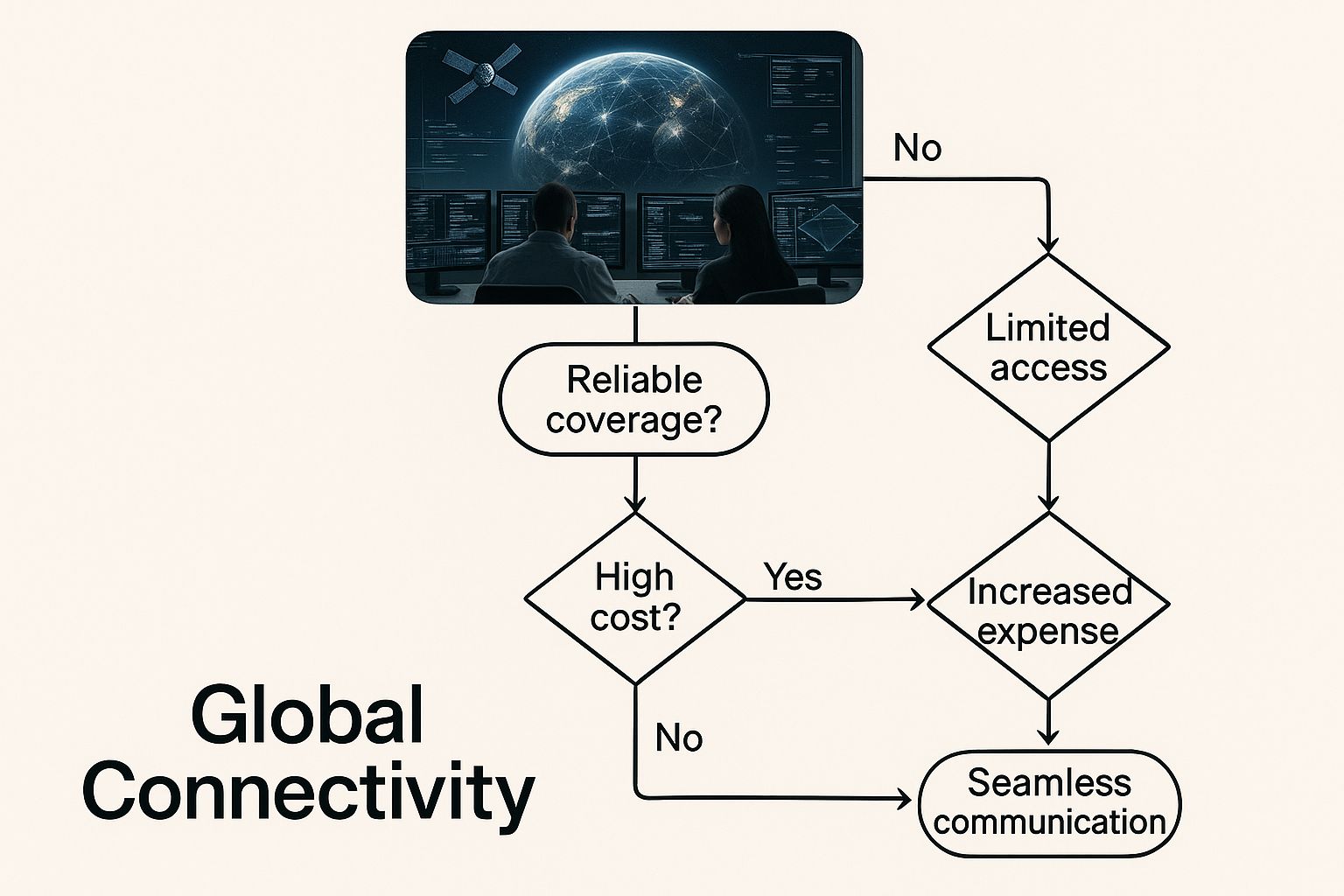
This is the nerve centre of satellite operations, where teams work around the clock to ensure those data and communication links are stable and ready for everyone out in the field.
Essential Satellite Hardware For NZ Teams
Here in New Zealand, our challenging terrain demands communication gear that's tough and dependable. Choosing the right hardware really comes down to what your operation needs, whether that's basic emergency alerts or full two-way messaging and voice calls. Unlike general retailers, a specialist supplier has the hands-on experience and deep product knowledge to match your business with the right, legally compliant equipment.
Here are the key types of devices that form the backbone of remote team safety:
- Satellite Phones: Offering clear voice and basic data, devices from networks like Iridium and Inmarsat are the gold standard for direct, reliable communication just about anywhere on the planet. They're vital when you need to have a detailed chat, like coordinating a complex task or reporting specific incident details.
- Two-Way Satellite Communicators: These compact gadgets allow for text-based messaging well outside of mobile coverage. They're perfect for daily check-ins, sending short status updates, and providing GPS location tracking, which creates a digital breadcrumb trail confirming your team's location and safety.
- Personal Locator Beacons (PLBs) and EPIRBs: These are purely life-saving devices. Once activated, a PLB (for personal use) or an EPIRB (for marine vessels) blasts a distress signal with a unique code and GPS location straight to rescue coordination centres. Help gets dispatched as fast as possible.
For any business with teams in isolated environments, equipping them with the right satellite device isn't just a good idea—it's a non-negotiable part of your health and safety obligations. It’s an investment in your people's wellbeing and your company’s integrity.
Choosing The Right Satellite Device For Your NZ Business
Selecting the right device can feel overwhelming, but breaking it down by function helps clarify what your team truly needs to stay safe and productive. This table compares the main options to help you find the best fit.
| Device Type | Primary Function | Ideal NZ Business Scenario | Key Benefit |
|---|---|---|---|
| Satellite Phone | Voice calls & basic data | A backcountry guiding company needing to confirm logistics with base camp or handle a client medical issue. | Detailed, real-time verbal communication. |
| 2-Way Communicator | Text messaging & GPS tracking | A forestry crew needing to send daily "all-clear" messages and share their precise location for pickup. | Cost-effective, non-urgent messaging and location awareness. |
| Personal Locator Beacon | SOS distress signal | An agricultural consultant working alone on a remote farm who suffers a serious injury far from help. | Simple, one-button activation for life-threatening emergencies only. |
| EPIRB | Marine-specific SOS distress | A commercial fishing vessel that loses power and begins taking on water 50 nautical miles offshore. | Internationally recognised maritime distress signal. |
Ultimately, the best solution often involves a mix of these technologies, ensuring you have layers of protection for different situations.
Practical Scenarios For Enhanced Safety
To see the real-world impact, picture a survey crew working in a remote part of the central North Island. The team leader uses a two-way satellite communicator to send a quick check-in message every couple of hours, confirming their status and GPS coordinates. It’s a simple action, but it provides huge peace of mind back at the office and creates a clear record of their movements. If a small issue pops up—a vehicle breakdown or a minor injury—they can message for assistance without triggering a full-blown emergency response.
Likewise, a commercial fishing vessel can use its satellite system for more than just its emergency EPIRB. It can receive critical weather updates and report catch data, improving both safety and business outcomes. To build even greater resilience, businesses can integrate satellite solutions into wider strategies like robust business continuity planning. Taking a look at the best communication tools for remote teams can offer more ideas for creating a complete safety framework.
At the end of the day, satellite devices empower businesses to build a safety culture that's proactive, not just reactive. Here at Mobile Systems, we specialise in providing these essential satellite solutions in New Zealand, helping businesses choose and implement the right technology to keep their teams connected and safe, no matter where the job takes them.
Global Satellite Innovations and Their Local Impact
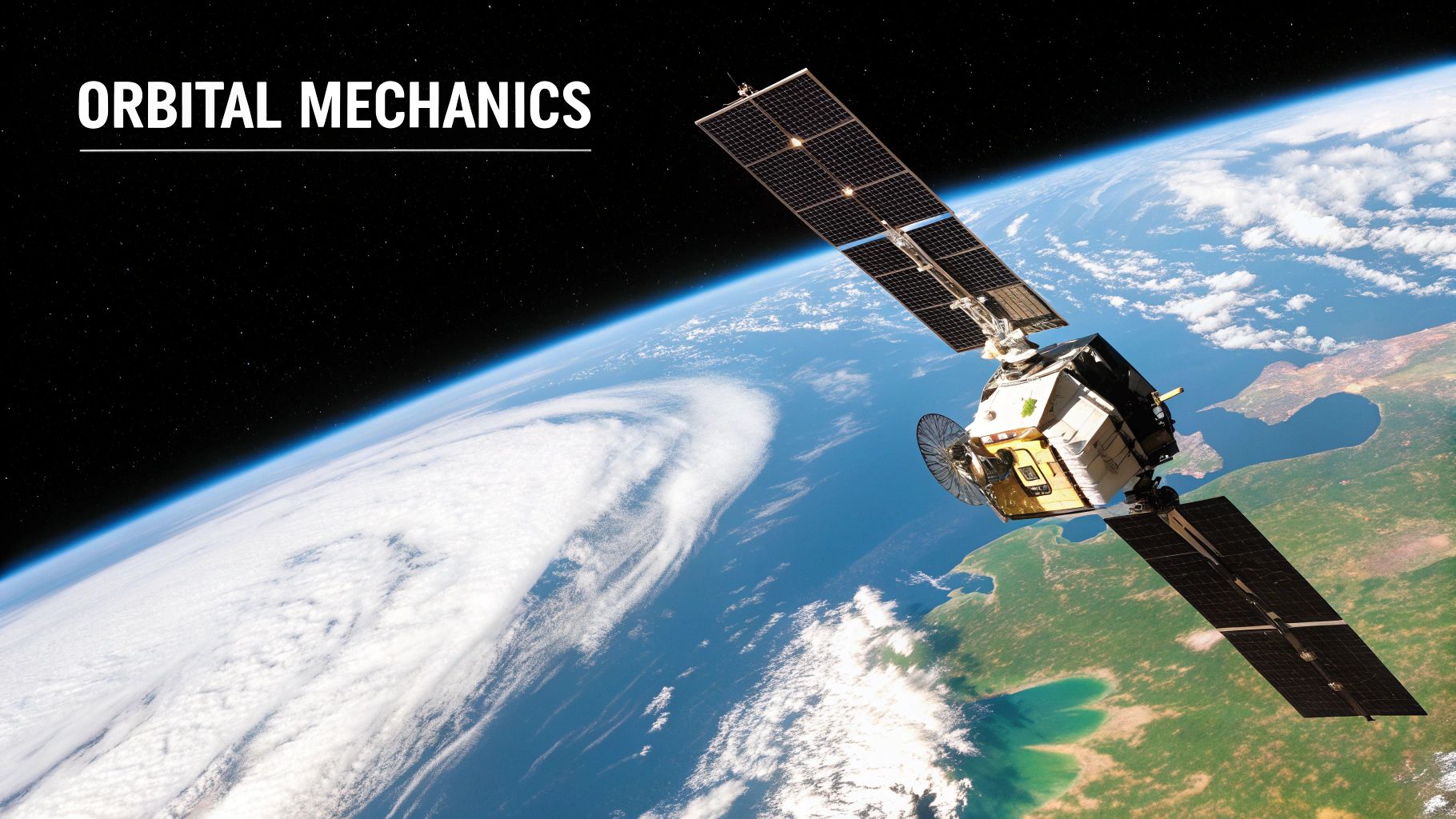
The satellite industry is experiencing a massive global transformation, and New Zealand is more involved than most people realise. What was once a field dominated by governments and giant corporations is now becoming accessible and affordable, leading to tangible benefits for local businesses needing to keep their teams safe and connected. These developments are directly impacting the communication devices available in New Zealand, driving productivity and improving safety outcomes.
This whole shift comes down to two huge global trends that are completely changing the rules of space-based communication. Once you understand them, it’s easy to see why satellite tech is now a practical tool for improving safety and productivity right across New Zealand.
The Rise of LEO Constellations
For years, communication satellites lived in high geostationary orbits (GEO), about 36,000 kilometres up. They were reliable, but that massive distance created a noticeable delay—or latency—in the signal. Great for broadcasting TV, but not so great for real-time voice calls or interactive data.
Now, a new generation of Low Earth Orbit (LEO) satellite constellations is changing everything. We’re talking about huge networks of smaller, cheaper satellites orbiting much, much closer to us, typically between 500 and 2,000 kilometres high.
By flying closer to the ground, LEO satellite systems slash that signal delay. This means faster, more responsive internet and crystal-clear voice calls, making them a powerful alternative to traditional networks in remote spots.
This proximity creates an experience that feels a lot more like fibre or 4G, opening the door for data-heavy work that was just impossible over satellite before.
The Impact of Reusable Rockets
The second piece of the puzzle is the arrival of reusable rockets. Launching a satellite used to be an incredibly expensive, one-shot deal. Today, companies have cracked the code on landing and reusing rocket boosters, which has sent the cost of getting things into orbit plummeting.
Think of it this way: launching satellites is becoming less like a once-in-a-lifetime moon mission and more like a routine cargo flight. This is what makes it financially possible to deploy the thousands of satellites needed for those big LEO constellations.
New Zealand's Role in the Global Satellite Boom
New Zealand isn’t just watching this happen from the sidelines; we’re an important part of the action. This domestic involvement means Kiwi businesses have better access to the latest satellite communication devices designed to enhance team safety and connectivity. The expertise driving the global satellite revolution is literally in our own backyard.
These global breakthroughs deliver direct, real-world benefits for Kiwi businesses, making powerful communication tools more accessible than ever. We're seeing practical innovations pop up all the time, like the INF RTK V2 and INF RTK Base Station, which gives industries like agriculture and construction centimetre-level accuracy for height measurements—a total game-changer for precision work.
As these technologies keep evolving, the opportunities for New Zealand businesses will only get bigger. At Mobile Systems, we specialise in helping local businesses tap into these advancements, providing expert advice on satellite solutions that improve safety, boost productivity, and keep teams connected, no matter how far off the grid they are.
Understanding Starlink's Role in New Zealand
The name Starlink is popping up everywhere, but what does its arrival actually mean for businesses and our wider economy here in New Zealand? This groundbreaking Low Earth Orbit (LEO) satellite internet isn't just another way to get online; it's a massive step towards closing the digital divide that has held back our rural and remote regions for years, with a significant expected impact on communications and the national economy.
At its heart, Starlink uses a huge web of thousands of small satellites that fly much, much closer to Earth than the traditional ones. This proximity is the secret sauce—it drastically cuts down the signal delay, or latency, giving you high-speed internet that feels more like city fibre than the sluggish satellite services of old.
For any business operating beyond the reach of the cellular network, this is a total game-changer. It delivers the kind of bandwidth needed for modern, data-hungry operations that were simply impossible in isolated areas until now.
Fuelling a More Connected New Zealand Economy
The impact of having reliable, fast internet in every corner of the country is hard to overstate. This isn't just about faster streaming; it's about unlocking brand new economic opportunities and boosting productivity in the very sectors that are vital to New Zealand's growth.
Just think about these real-world scenarios:
- Precision Agriculture: A high-country farm can now use real-time data from soil sensors and drones to perfectly time irrigation and fertiliser use. The result? Higher yields and a lighter environmental footprint.
- Remote Tourism: That backcountry lodge deep in Fiordland or the Southern Alps can finally offer guests decent Wi-Fi, completely transforming the visitor experience and opening up new ways to market themselves.
- Smarter Logistics: A nationwide trucking fleet can maintain a constant data connection, allowing for live vehicle tracking, smart route optimisation, and instant chats with drivers no matter where they are.
This level of connectivity supercharges regional development by allowing businesses to thrive from anywhere. It also makes remote work a genuine option, empowering skilled Kiwis to live and contribute to local economies in places they love, rather than being chained to the main centres. If you want to dive deeper into the nuts and bolts, you can learn more about how Starlink's satellite system works in our detailed guide.
By providing a robust digital backbone to underserved areas, Starlink helps level the playing field, ensuring geography is no longer a barrier to economic participation and innovation.
Starlink Within the Broader Communications Ecosystem
While Starlink delivers incredible data performance, it's crucial to see it as one powerful tool in a much bigger communications toolkit. It's brilliant at providing high-speed internet, but it doesn't replace the specialised safety functions of other satellite gear.
For example, a remote construction site might use a Starlink dish to connect the site office for sending large blueprints and running cloud-based software. At the same time, the crew out on the job will still depend on rugged two-way satellite communicators or sat phones for constant, reliable voice and text check-ins. These devices are built for mobility and life-or-death situations, running on ultra-reliable networks like Iridium.
The smartest approach for any business is to build a layered communication strategy. This means using Starlink for your high-bandwidth office needs while equipping your teams with dedicated safety devices like PLBs or satellite phones to meet health and safety obligations and handle emergencies. This ensures you've got every angle covered—from productivity to people.
At Mobile Systems, we specialise in putting together these kinds of integrated satellite solutions for New Zealand businesses. We can help you figure out exactly where Starlink fits and pair it with the right gear to keep your team safe, connected, and getting the job done.
New Zealand's Strategic Place in the Space Economy
New Zealand's growing role in the global space race is much more than a point of national pride. For local businesses, it’s a strategic advantage that brings world-class connectivity right to our doorstep. Our nation has quietly become a small but mighty force in the international space industry, creating a domestic ecosystem that’s ready to support Kiwi companies with top-tier satellite solutions.
This didn't happen by accident. It's the result of a powerful combination of smart government policy, private sector drive, and a one-of-a-kind geographical advantage. Together, these elements mean New Zealand is no longer just a consumer of satellite technology but a key contributor to its global development.
Forward-Thinking Regulation Creates Stability
One of the biggest factors in our success is a clear and supportive regulatory framework. The government recognised the potential of the space industry early on, creating laws that encourage innovation while making sure everything is done safely and responsibly.
The cornerstone of this is the Outer Space and High Altitude Activities Act 2017. This legislation provides a stable and predictable environment for companies looking to launch and operate satellites from New Zealand. It simplifies the process, making our country an attractive base for both homegrown and international space ventures.
This forward-thinking approach sends a clear message to the world: New Zealand is open for space business. It fosters a climate where innovation can thrive, which in turn leads to better, more accessible satellite services for businesses on the ground.
The Māhia Peninsula: A Unique Geographical Asset
Alongside smart policy, New Zealand has a remarkable natural advantage—the Māhia Peninsula. Located on the east coast of the North Island, its unique position makes it one of the best places in the world to launch satellites into specific, highly valuable orbits.
From this spot, it’s possible to send satellites into sun-synchronous orbits, which are critical for Earth observation missions like monitoring climate change or agricultural land. The site also provides clear launch corridors over the vast Pacific Ocean, minimising risk and making logistics much simpler.
This rare combination of geography and regulation gives New Zealand a distinct edge. It has allowed private companies to establish world-class launch facilities that are central to the modern satellite economy.
A Hub for Global Satellite Operations
This blend of supportive policy and a prime location has turned New Zealand into a vital hub for orbital launches. Our country’s space activity is largely defined by Rocket Lab’s operational base at Māhia, which provides uniquely licensed facilities capable of supporting up to 120 launches per year. This positions us as one of the few nations with a fully operational private orbital launch range, offering consistent and reliable access to space for a wide range of satellite missions headed for low Earth orbit (LEO).
You can explore more about our country's unique position and capabilities in this detailed NRO report.
This domestic capability is about more than just sending rockets into the sky. It nurtures a local industry of engineers, technicians, and software developers who are at the forefront of satellite technology. For New Zealand businesses, this means having access to homegrown expertise and cutting-edge solutions designed to solve our unique connectivity challenges.
At Mobile Systems Limited, we work closely with businesses across New Zealand to harness the power of this technology. We can help you navigate the ever-growing range of satellite solutions—from rugged communication devices to high-speed data terminals—to ensure your team stays safe, connected, and productive, no matter where your work takes you.
Finding the Right Satellite Solution for Your Business
Knowing how powerful satellite technology can be is one thing, but picking the right tools for your specific job is a whole different ball game. With options ranging from high-speed data with Starlink to life-saving personal communicators, the market can be tricky to navigate without some real expertise.
This is where working with a specialist provider really pays off. Unlike generalist retailers with a limited range and even less product knowledge, a dedicated communication expert takes the time to understand your unique operational needs. The goal is to get your team kitted out with high-quality, legally compliant gear that actually solves the challenges you face on the ground.
Charting a Path to Connectivity
The right solution always comes down to what your business does. A forestry crew might just need rugged, handheld satellite phones for voice calls, while a remote farm could get more value from a fixed Starlink installation for data, backed up by PLBs for lone worker safety.
An expert partner cuts through the noise by asking the important questions:
- What’s your main reason for needing it—voice, text, data, or emergency SOS?
- How many of your team members need to be connected?
- What are the specific environmental challenges at your worksite (like dense tree cover or marine conditions)?
Making an informed decision empowers you to use the right satellite technology to improve safety, boost productivity, and drive your business forward in New Zealand's demanding environments.
Your Partner in Satellite Communications
A specialist does more than just sell you a box; they deliver a complete solution. That includes helping with device programming, network setup, and ongoing support to make sure your investment actually delivers real-world value. The aim is to build a reliable communication framework that slots right into your daily operations. You can learn more about the specifics in our guide to satellite internet in New Zealand.
At Mobile Systems, we have the deep industry experience to help with all your satellite needs in New Zealand. We can help your business reap the benefits of modern connectivity, ensuring your teams are always safe and always in touch.
Got Questions About Satellite Comms?
Stepping into the world of satellite technology can bring up a few questions, especially when you're trying to figure out the best fit for your business here in New Zealand. We get it. Here are the answers to some of the most common queries we hear.
What's The Main Difference Between Starlink And A Satellite Phone?
It really comes down to data versus voice. Think of Starlink as a satellite internet service. It’s designed to give you high-speed, broadband-style data for things like video calls, cloud computing, and general web browsing in a fixed spot, like a remote worksite.
A satellite phone, on the other hand, is a tough, portable device built purely for reliable voice calls and short texts from literally anywhere on the planet. While Starlink is great for getting an office online, a sat phone is the go-to tool for mobile teams who need guaranteed voice comms for safety checks and critical updates.
Is Satellite Gear Expensive In New Zealand?
In the past, yes, satellite technology was pretty pricey. But that's changed dramatically. Thanks to new LEO constellations and advances like reusable rocket technology, both the hardware and the service costs have dropped significantly.
While there's still an upfront investment, the price is now well within reach for most businesses. When you consider the huge payoff in safety, productivity, and efficiency for your remote operations, it makes a lot of sense. Flexible plans and hire options also make it easier than ever to get started.
Do I Need A Special Licence To Use Satellite Devices?
Good news—for most of the common satellite gear, you don't. For devices like satellite phones, two-way messengers from providers like Iridium or Inmarsat, and Personal Locator Beacons (PLBs), you won’t need a specific licence to use them in New Zealand. They're built for public use.
However, if you're looking at more specialised satellite terminals or a complex network installation, there might be some specific rules to follow. A good supplier can easily walk you through any compliance stuff needed for your particular setup.
Can The Weather Mess With My Satellite Signal?
Modern satellite systems are incredibly robust, but very nasty weather can sometimes have an impact. You might hear the term "rain fade," which can happen during an extremely heavy downpour. The sheer amount of water in the atmosphere can absorb some of the radio frequency energy travelling between your device and the satellite.
That said, for mission-critical gear like Iridium satellite phones or PLBs, the networks are engineered for extreme reliability—we're talking over 99% uptime. They are far less likely to be affected by weather than consumer-grade data services. They are simply built to work when you need them most, no questions asked.
Ready to see how satellite technology can give your New Zealand business an edge? The experts at Mobile Systems Limited can give you practical advice and help find the perfect solution to keep your team safe, connected, and productive.

